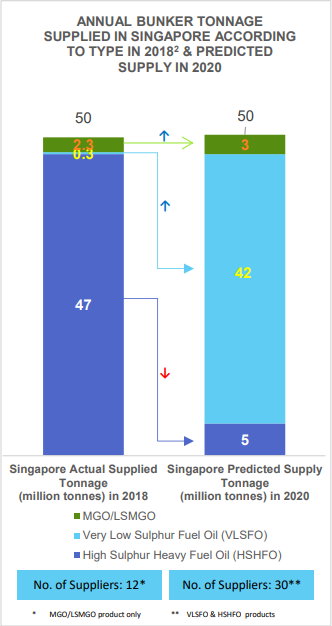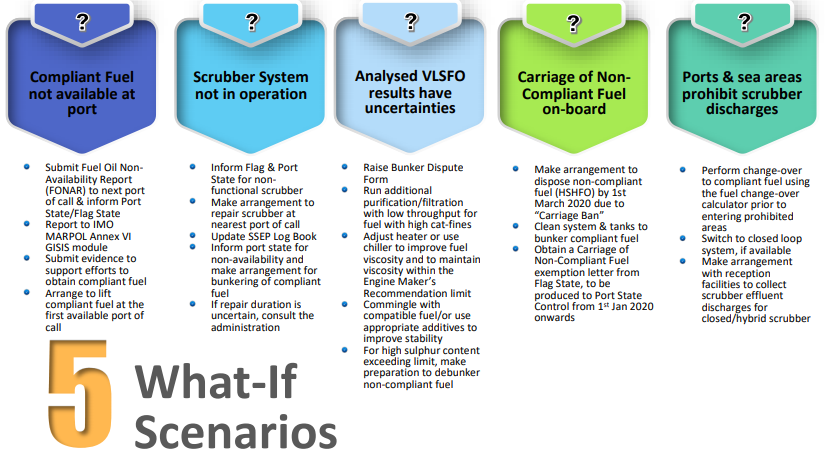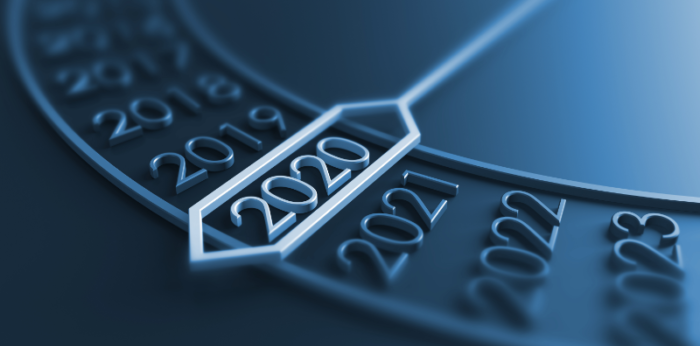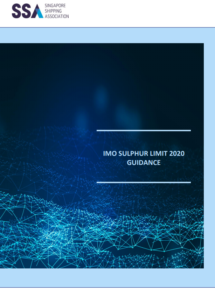The Singapore Shipping Association (SSA) issued the ‘IMO Sulphur Cap 2020 Readiness Plan’ for Singapore’s shipping community. The document provides an overview of the key requirements of the IMO 2020 global sulphur cap, describes the major preparatory milestones in the lead up to January 2020, and presents key compliance measures.
As the report says, the IMO sulphur limit would reduce SOx emissions by 85%, but compliance with the measure will increase the average fuel price by as much as 26%. In addition, the average energy will increase by 2.5%, with the average OPEX growing by 13%.

Types of alternatives and their locations
SSA outlines 4 kinds of alternatives for compliance with the IMO 2020 sulphur cap. These are:
1. LNG, located in:
- Singapore;
- Rotterdam;
- Fujairah;
- China;
- US;
- Canada;
- Norway;
- Japan;
- Korea etc.
2. Methanol, located in:
- Rotterdam;
- Japan;
- New Zealand;
- Europe;
- North;
- America;
- Asia Pacific (via trucks).
3. Ethanol, located in:
- US;
- Europe (via trucks).
4. Bio-fuel, located in:
- Rotterdam;
- Finland;
- US (via trucks).
Regarding the annual bunker tonnage supplied in Singapore, in 2018 47 million tonnes of High Sulphur Heavy Fuel Oil (HSHFO) were supplied, with 0.3 million tonnes of Very Low Sulphur Fuel Oil (VLSFO), and 2.3 million tonnes of MGO/LSMGO.
[smlsubform prepend=”GET THE SAFETY4SEA IN YOUR INBOX!” showname=false emailtxt=”” emailholder=”Enter your email address” showsubmit=true submittxt=”Submit” jsthanks=false thankyou=”Thank you for subscribing to our mailing list”]
For 2020, SSA expects 42 million tonnes of VLSFO to be supplied, followed by 5 million tonnes of HSHFO and 3 million tonnes of MGO/LSMGO.

Necessary documents
In order to showcase compliance with the upcoming regulation, every actor involved must present certain documents. These would be:
Company docs
- Ship Management System updated;
- Ship Implementation Plan reviewedFuel Oil Changeover Plan prepared & reviewed;
- Crew Preparedness Training Plan executed;
- RA & Mitigation Plan for use of DM/RM onboard reviewed;
- Carriage Ban instructions prepared;
- Commingling instructions prepared.
Class docs
- EIAPP New Certificate Received;
- Amended NOx Technical File (obtained only in case of changing component);
- CEM documentation maintained both onboard and in cloud;
- IMO GSIS System familiarisation conducted;
- Fuel system plan approval received (needed in case of line modifications);
- Onboard Monitoring Manual approved > SOX Emission Compliance Plan approved.
Ship docs
- SEEMP document updated;
- Tank & Sounding Sensors booklet configured with correct viscosities/temp;
- Maintenance Log incorporated with new equipment;
- Section H of Oil Record Book Part 1 new recording requirements incorporated;
- Procedures to verify machinery performance completed;
- Procedures for segregation of various grades of fuel oil carried out;
- ECGS Technical Manual for Scheme A/B received.
Records & Forms
- 3-years Bunker Delivery Notes (BDN) Records indicating % of Sulphur content available on board;
- FONAR Form Instructions disseminated & contact list of FONAR recipients developed;
- Fuel change over instructions updated;
- EGC Record Book updating instructions incorporated.
Supply chain docs
- BDN to indicate less than 0.5% of Sulphur Content and does not exceed the maximum allowable limit if no scrubber is installed onboard vessel after Jan 2020;
- Certificate of Quality (COQ) from suppliers received.
Planning for 2020 compliance
In order to better prepare for compliance with the 2020 sulphur cap, SS recommends a 6-months planning. During each month of this period, operators should adopt the following:
1st Month: Compliance
Ship maintenance regime to include mitigating compatibility issues, carriage ban arrangement, emission monitoring, equipment inoperability, CEM malfunction etc.
2nd Month: On board readiness
Fuel switch-over requirement arranged and full training on the utilization/ switch-over operation as well as handling unavailability of compliant fuel for crews completed, issuance of reminder that non-compliant fuel needs to be disposed.
3rd Month: Procurement readiness
Procurement contracts and quality procedure/certification to purchase compliant fuels from bunker suppliers along vessel routes negotiated and agreed, disposal of non-compliant fuel.
4th Month: Sampling readiness
All sampling points identified and appropriate sampling valve installed, procedure for onboard and in-use samples completed and crew familiarization training conducted.
5th Month: Oil tanks readiness
Tank cleaning for designated fuels storage arranged, lub oil spare tank arrangement for dual fuel carriage, additional containment system for the possible overflow of sludge volume due to tank cleaning requirements.
6th Month: Fuel oil system readiness
Segregation modifications for fuel oil tanks system completed, system lines tested, and crew familiarization training conducted, action plan agreed with manufacturers completed.
However, as several challenges are expected to occur, the report presents 5 such scenarios and what to do if they take place.

Risks Assessed Types
Finally, SSA members have compiled six possible risks that the shipping industry might face ahead of the 2020 sulphur cap, and potential mitigation measures. In summary, these risks are:
1. Vessel Collision
In this case, the report suggests the following measures:
- Configure alert/alarm system when switching fuel;
- Additional watchkeeping when performing fuel change over;
- Perform fuel change over well in advance in order to ensure smooth transition to avoid any blackout situations;
- Avoid performing fuel switch over in Port and Areas of restricted navigation, such as TSS, Rivers, Channels etc.;
- Familiarisation of fuel change over sequence within 3 months prior to regulations kick in.
2. Vessel Detention
To address such a situation, operators should:
- Use portable sulphur meter to test onboard and in-use fuel samples sulphur content;
- Safety briefings to include LSFO nonavailability or non-operational scrubber;
- Ensure all logs are properly maintained and recorded;
- Obtain Flag State approval for carriage of non-compliant fuel till March 2020;
- Delivered MARPOL LSFO has 0.47% Sulphur or less documented (+5% confidence level).
3. Damage to Critical Assets
If critical equipment is damaged, the following actions could provide the solution:
- Perform CLO Scrape Down Analysis every 3 months to maintain desired TBN/FE ratio;
- Additional before/after lab tests to ensure LSFO will not cause piston ring failure or fuel p/p seizure;
- Use purifiers at low throughput and test purifier efficiency of removing catfines by testing before/after;
- Develop correct Purification Procedures, based on fuel bunkered i.e. correct use of gravity disc /purification temperatures;
- Install acceptable micron backwash filter to reduce catfines & check/clean filters regularly.
4. Onboard Fuel Contamination
In case the fuels onboard are contaminated, SSA recommends to:
- Frequently use portable sulphur meter to test onboard and inuse fuel samples sulphur content;
- Drain water from fuel tanks to avoid settling of catfines;
- Test for compatibility prior to any commingling;
- Avoid mixing & do not use fuel without knowing its specifications;
- Monitor for sludge in tank & clean bunker tank residues frequently.
5. Incorrect combustion affecting emission values
In another scenario, should an improper combustion affects emission values, operators could:
- Install new fuel pump plunger/barrel and injection nozzles for low viscosity LSFO;
- Use new type of nozzles and adjust Air/Fuel ratio for boiler;
- Ensure appropriate Low TBN CLO/LO to avoid fouling of M/E, A/E rings/groves;
- Maintain fuel oil viscosity/ heating for recommended injection viscosity;
- Increase purifier desludge frequency to reduce sludge accumulation.
6. Supplied Fuel Quantity & Quality Disputes
Finally, if disputes arise regarding the supplied fuel’s quantity and quality, the report highlights the following:
- Install mass flow meters with correct viscosities range;
- Fuel tests report to be delivered by accredited testing labs within 4 hours;
- Procurement clauses for quantity & quality related issues with bunker suppliers;
- Avoid taking bunker from unreputable suppliers that do not comply with MARPOL Annex VI;
- Transition Clause between Charterer & Operator on tank/system fitness.
Explore more in the PDF herebelow





























































